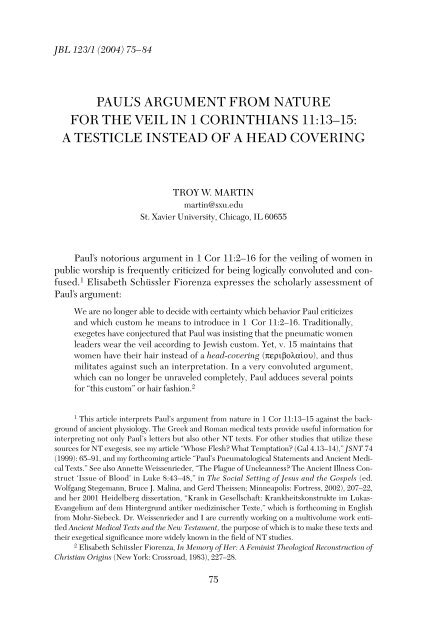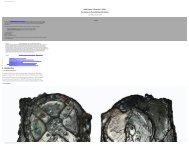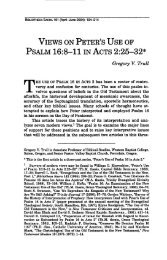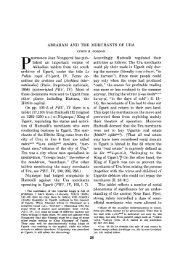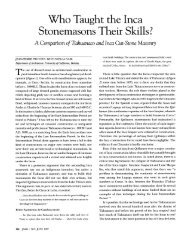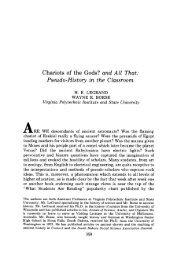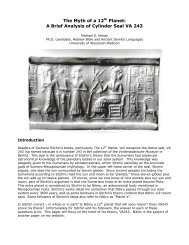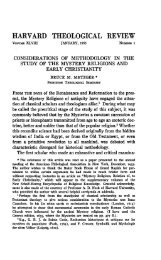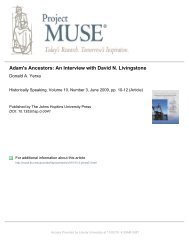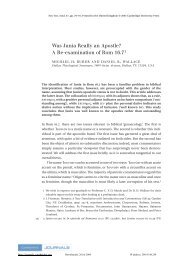Paul's Argument from Nature for the Veil in - Michael S. Heiser
Paul's Argument from Nature for the Veil in - Michael S. Heiser
Paul's Argument from Nature for the Veil in - Michael S. Heiser
Create successful ePaper yourself
Turn your PDF publications into a flip-book with our unique Google optimized e-Paper software.
JBL 123/1 (2004) 75–84<br />
PAUL’S ARGUMENT FROM NATURE<br />
FOR THE VEIL IN 1 CORINTHIANS 11:13–15:<br />
A TESTICLE INSTEAD OF A HEAD COVERING<br />
TROY W. MARTIN<br />
mart<strong>in</strong>@sxu.edu<br />
St. Xavier University, Chicago, IL 60655<br />
Paul’s notorious argument <strong>in</strong> 1 Cor 11:2–16 <strong>for</strong> <strong>the</strong> veil<strong>in</strong>g of women <strong>in</strong><br />
public worship is frequently criticized <strong>for</strong> be<strong>in</strong>g logically convoluted and confused.<br />
1 Elisabeth Schüssler Fiorenza expresses <strong>the</strong> scholarly assessment of<br />
Paul’s argument:<br />
We are no longer able to decide with certa<strong>in</strong>ty which behavior Paul criticizes<br />
and which custom he means to <strong>in</strong>troduce <strong>in</strong> 1 Cor 11:2–16. Traditionally,<br />
exegetes have conjectured that Paul was <strong>in</strong>sist<strong>in</strong>g that <strong>the</strong> pneumatic women<br />
leaders wear <strong>the</strong> veil accord<strong>in</strong>g to Jewish custom. Yet, v. 15 ma<strong>in</strong>ta<strong>in</strong>s that<br />
women have <strong>the</strong>ir hair <strong>in</strong>stead of a head-cover<strong>in</strong>g (peribolaivou), and thus<br />
militates aga<strong>in</strong>st such an <strong>in</strong>terpretation. In a very convoluted argument,<br />
which can no longer be unraveled completely, Paul adduces several po<strong>in</strong>ts<br />
<strong>for</strong> “this custom” or hair fashion. 2<br />
1 This article <strong>in</strong>terprets Paul’s argument <strong>from</strong> nature <strong>in</strong> 1 Cor 11:13–15 aga<strong>in</strong>st <strong>the</strong> background<br />
of ancient physiology. The Greek and Roman medical texts provide useful <strong>in</strong><strong>for</strong>mation <strong>for</strong><br />
<strong>in</strong>terpret<strong>in</strong>g not only Paul’s letters but also o<strong>the</strong>r NT texts. For o<strong>the</strong>r studies that utilize <strong>the</strong>se<br />
sources <strong>for</strong> NT exegesis, see my article “Whose Flesh? What Temptation? (Gal 4.13–14),” JSNT 74<br />
(1999): 65–91, and my <strong>for</strong>thcom<strong>in</strong>g article “Paul’s Pneumatological Statements and Ancient Medical<br />
Texts.” See also Annette Weissenrieder, “The Plague of Uncleanness? The Ancient Illness Construct<br />
‘Issue of Blood’ <strong>in</strong> Luke 8:43–48,” <strong>in</strong> The Social Sett<strong>in</strong>g of Jesus and <strong>the</strong> Gospels (ed.<br />
Wolfgang Stegemann, Bruce J. Mal<strong>in</strong>a, and Gerd Theissen; M<strong>in</strong>neapolis: Fortress, 2002), 207–22,<br />
and her 2001 Heidelberg dissertation, “Krank <strong>in</strong> Gesellschaft: Krankheitskonstrukte im Lukas-<br />
Evangelium auf dem H<strong>in</strong>tergrund antiker mediz<strong>in</strong>ischer Texte,” which is <strong>for</strong>thcom<strong>in</strong>g <strong>in</strong> English<br />
<strong>from</strong> Mohr-Siebeck. Dr. Weissenrieder and I are currently work<strong>in</strong>g on a multivolume work entitled<br />
Ancient Medical Texts and <strong>the</strong> New Testament, <strong>the</strong> purpose of which is to make <strong>the</strong>se texts and<br />
<strong>the</strong>ir exegetical significance more widely known <strong>in</strong> <strong>the</strong> field of NT studies.<br />
2 Elisabeth Schüssler Fiorenza, In Memory of Her: A Fem<strong>in</strong>ist Theological Reconstruction of<br />
Christian Orig<strong>in</strong>s (New York: Crossroad, 1983), 227–28.<br />
75
76<br />
Similarly, Victor Paul Furnish comments:<br />
Journal of Biblical Literature<br />
There is no doubt that Paul also means to provide a <strong>the</strong>ological basis <strong>for</strong> his<br />
<strong>in</strong>structions about <strong>the</strong> hairstyle of women who pray or prophesy, but <strong>in</strong> this<br />
case his argument is obscure, at least to modern <strong>in</strong>terpreters, and it may well<br />
have seemed unsatisfactory even to <strong>the</strong> apostle himself. At any rate, <strong>in</strong> <strong>the</strong><br />
end he abandons argument altoge<strong>the</strong>r by suggest<strong>in</strong>g that if his directives are<br />
not followed <strong>the</strong> Cor<strong>in</strong>thians will be depart<strong>in</strong>g <strong>from</strong> <strong>the</strong> convention that<br />
obta<strong>in</strong>s <strong>in</strong> o<strong>the</strong>r congregations (v. 16). 3<br />
Describ<strong>in</strong>g Paul’s argument as “bewilder<strong>in</strong>gly difficult,” Marion L. Soards<br />
states, “One hopes that <strong>the</strong> Cor<strong>in</strong>thians had an easier time follow<strong>in</strong>g Paul’s logic<br />
than do modern readers.” 4 One may hope, but <strong>the</strong> scholarly assessment is that<br />
nei<strong>the</strong>r <strong>the</strong> Cor<strong>in</strong>thians nor possibly even Paul himself completely comprehended<br />
this argument <strong>for</strong> <strong>the</strong> veil<strong>in</strong>g of women.<br />
While many features of this argument <strong>in</strong> 1 Cor 11:2–16 require explanation,<br />
<strong>the</strong> argument <strong>from</strong> nature <strong>in</strong> vv. 13–15 is particularly problematic. 5 The<br />
rationale <strong>for</strong> <strong>the</strong> natural shame of a man with long hair is obscure (vv. 14–15a).<br />
Especially problematic is <strong>the</strong> statement that a woman’s long hair is given to her<br />
<strong>in</strong>stead of a cover<strong>in</strong>g (ajnti; peribolaivou) <strong>in</strong> v. 15b. As traditionally understood,<br />
this statement nullifies <strong>the</strong> previous argument that a woman should wear a cover<strong>in</strong>g<br />
s<strong>in</strong>ce her long hair apparently serves that purpose. A satisfactory explanation<br />
of this argument <strong>from</strong> nature should resolve <strong>the</strong> apparent contradiction<br />
and enable this argument to support Paul’s contention that women should wear<br />
<strong>the</strong> veil <strong>in</strong> public worship.<br />
The term peribovlaion <strong>in</strong> v. 15b provides <strong>the</strong> key <strong>for</strong> expla<strong>in</strong><strong>in</strong>g this argument<br />
<strong>from</strong> nature. This portion of <strong>the</strong> verse is usually translated, “For her hair<br />
is given to her <strong>in</strong>stead of a cover<strong>in</strong>g (peribolaivou).” In an <strong>in</strong>fluential article,<br />
Othoniel Motta argues that peribovlaion here means some type of head cover<strong>in</strong>g.<br />
Paul Ell<strong>in</strong>gworth and Howard Hatton expla<strong>in</strong>, “The word translated cover<strong>in</strong>g<br />
is a general word <strong>for</strong> a garment, possibly one used as an outer cover<strong>in</strong>g.<br />
Although it does not specify any particular piece of cloth<strong>in</strong>g, <strong>the</strong>re seems to be<br />
an obvious relation between this verse and <strong>the</strong> discussion <strong>in</strong> verses 4 and 5<br />
about a cover<strong>in</strong>g <strong>for</strong> <strong>the</strong> head.” 6 Even though <strong>the</strong>se scholars have identified <strong>the</strong><br />
3 Victor Paul Furnish, The Theology of <strong>the</strong> First Letter to <strong>the</strong> Cor<strong>in</strong>thians (New Testament<br />
Theology; Cambridge: Cambridge University Press, 1999), 77.<br />
4 Marion L. Soards, 1 Cor<strong>in</strong>thians (NIBCNT; Peabody, MA: Hendrickson, 1999), 221, 224.<br />
5 For an analysis of <strong>the</strong> entire argument, see Troy W. Mart<strong>in</strong>, “<strong>Veil</strong>ed Exhortations Regard<strong>in</strong>g<br />
<strong>the</strong> <strong>Veil</strong>: Ethos as <strong>the</strong> Controll<strong>in</strong>g Factor <strong>in</strong> Moral Persuasion (1 Cor 11:2-16),” <strong>for</strong>thcom<strong>in</strong>g <strong>in</strong> <strong>the</strong><br />
collection of papers <strong>from</strong> <strong>the</strong> 2002 Heidelberg Rhetoric Conference.<br />
6 Othoniel Motta, “The Question of <strong>the</strong> Unveiled Woman (1 Co. 11.2:16),” ExpTim 44<br />
(1933): 139–41; Paul Ell<strong>in</strong>gworth and Howard Hatton, A Translator’s Handbook on Paul’s First<br />
Letter to <strong>the</strong> Cor<strong>in</strong>thians (Helps <strong>for</strong> Translators; London: United Bible Societies, 1985), 221.
Mart<strong>in</strong>: Paul’s <strong>Argument</strong> <strong>in</strong> 1 Cor<strong>in</strong>thians 11:13–15 77<br />
dom<strong>in</strong>ant semantic doma<strong>in</strong> of this word, <strong>the</strong> term peribovlaion has a much<br />
broader semantic range.<br />
S<strong>in</strong>ce peribovlaion is contrasted with hair, which is part of <strong>the</strong> body, <strong>the</strong><br />
physiological semantic doma<strong>in</strong> of peribovlaion <strong>in</strong> 1 Cor 11:15b becomes particularly<br />
relevant. Euripides (Herc. fur. 1269) uses peribovlaion <strong>in</strong> reference to a<br />
body part. He casts Hercules as compla<strong>in</strong><strong>in</strong>g, “After I received [my] bags of<br />
flesh, which are <strong>the</strong> outward signs of puberty, [I received] labors about which I<br />
[shall] undertake to say what is necessary” (ejpei; de; sarko;" peribovlai! ejkthsavmhn<br />
hJbw'nta, movcqou" ou}" e[tlhn tiv dei' levge<strong>in</strong>). A dynamic translation of <strong>the</strong><br />
first clause would be: “After I received my testicles (peribovlaia), which are <strong>the</strong><br />
outward signs of puberty.” In this text <strong>from</strong> Euripides, <strong>the</strong> term peribovlaion<br />
refers to a testicle. 7<br />
Achilles Tatius (Leuc. Clit. 1.15.2) plays on this mean<strong>in</strong>g of peribovlaion <strong>in</strong><br />
his erotic description of a garden <strong>in</strong> which Clitophon seeks an amorous<br />
encounter with Leucippe. Achilles Tatius describes <strong>the</strong> entw<strong>in</strong><strong>in</strong>gs of <strong>the</strong> flowers,<br />
embrac<strong>in</strong>gs of <strong>the</strong> leaves, and <strong>in</strong>tercourses of <strong>the</strong> fruits (aiJ tw'n petavlwn<br />
periplokaiv, tw'n fuvllwn peribolaiv, tw'n karpw'n sumplokaiv). He portrays this<br />
erotic garden by allusions to male and female sexual organs. The term<br />
periplokaiv alludes to <strong>the</strong> female hair, <strong>the</strong> term peribolaiv to <strong>the</strong> testicles <strong>in</strong><br />
males, and <strong>the</strong> term sumplokaiv to <strong>the</strong> mix<strong>in</strong>g of male and female reproductive<br />
fluid <strong>in</strong> <strong>the</strong> female. Achilles Tatius’s description of this garden associates female<br />
hair and <strong>the</strong> testicle <strong>in</strong> males. 8<br />
Ancient medical conceptions confirm this association. Hippocratic authors<br />
hold that hair is hollow and grows primarily <strong>from</strong> ei<strong>the</strong>r male or female reproductive<br />
fluid or semen flow<strong>in</strong>g <strong>in</strong>to it and congeal<strong>in</strong>g (Hippocrates, Nat. puer.<br />
20). 9 S<strong>in</strong>ce hollow body parts create a vacuum and attract fluid, hair attracts<br />
semen. Appropriately, <strong>the</strong> term kovmh refers not only to hair but also to <strong>the</strong> arms<br />
or suckers of <strong>the</strong> cuttlefish (see Maximus of Tyre, Phil. 4.5). Hair grows most<br />
prolifically <strong>from</strong> <strong>the</strong> head because <strong>the</strong> bra<strong>in</strong> is <strong>the</strong> place where <strong>the</strong> semen is<br />
7 Words <strong>in</strong> <strong>the</strong> semantic doma<strong>in</strong> of cloth<strong>in</strong>g also occur <strong>in</strong> <strong>the</strong> semantic doma<strong>in</strong> of body parts.<br />
For example, <strong>the</strong> hippocratic author of Fleshes (Hippocrates, Carn. 3) likens membranes to tunics<br />
(citw'na"). Some may <strong>in</strong>terpret Euripides’ statement as referr<strong>in</strong>g to <strong>the</strong> scrotum, but <strong>the</strong> plural<br />
peribovlaia more likely refers to <strong>the</strong> testicles ra<strong>the</strong>r than <strong>the</strong> scrotum (o[sch), which is s<strong>in</strong>gular.<br />
Fur<strong>the</strong>rmore, <strong>the</strong> scrotum is visible <strong>from</strong> birth, whereas <strong>the</strong> testicles enlarge and become pronounced<br />
at puberty.<br />
8 For o<strong>the</strong>r texts that describe erotic gardens, see Erotica Antiqua: Acta of <strong>the</strong> International<br />
Conference on <strong>the</strong> Ancient Novel (ed. B. P. Reardon; Bangor: ICAN, 1977), 34–35.<br />
9 Émile Littré, Oeuvres completes d’Hippocrate (10 vols.; Paris: J. B. Baillière, 1839–61;<br />
repr., Amsterdam, 1961–62), 7.506.23–7.510.17. For a summary of <strong>the</strong> Hippocratic and Aristotelian<br />
conceptions of hair, see Lesley Dean-Jones, Women’s Bodies <strong>in</strong> Classical Greek Science<br />
(Ox<strong>for</strong>d: Clarendon, 1994), 83–85.
78<br />
Journal of Biblical Literature<br />
produced or at least stored (Hippocrates, Genit. 1). 10 Hair grows only on <strong>the</strong><br />
head of prepubescent humans because semen is stored <strong>in</strong> <strong>the</strong> bra<strong>in</strong> and <strong>the</strong><br />
channels of <strong>the</strong> body have not yet become large enough <strong>for</strong> reproductive fluid<br />
to travel throughout <strong>the</strong> body (Hippocrates, Nat. puer. 20; Genit. 2). 11 At<br />
puberty, secondary hair growth <strong>in</strong> <strong>the</strong> pubic area marks <strong>the</strong> movement of<br />
reproductive fluid <strong>from</strong> <strong>the</strong> bra<strong>in</strong> to <strong>the</strong> rest of <strong>the</strong> body (Hippocrates, Nat.<br />
puer. 20; Genit. 1). 12 Women have less body hair not only because <strong>the</strong>y have<br />
less semen but also because <strong>the</strong>ir colder bodies do not froth <strong>the</strong> semen<br />
throughout <strong>the</strong>ir bodies but reduce semen evaporation at <strong>the</strong> ends of <strong>the</strong>ir hair<br />
(Hippocrates, Nat. puer. 20). 13<br />
Accord<strong>in</strong>g to <strong>the</strong>se medical authors, men have more hair because <strong>the</strong>y<br />
have more semen and <strong>the</strong>ir hotter bodies froth this semen more readily<br />
throughout <strong>the</strong>ir whole bodies (Hippocrates, Nat. puer. 20). The nature (fuvsi")<br />
of men is to release or eject <strong>the</strong> semen. 14 Dur<strong>in</strong>g <strong>in</strong>tercourse, semen has to fill<br />
all <strong>the</strong> hollow hairs on its way <strong>from</strong> <strong>the</strong> male bra<strong>in</strong> to <strong>the</strong> genital area (Aristotle,<br />
Probl. 893b.10–17). Thus, men have hair growth on <strong>the</strong>ir face, chest, and stomach.<br />
A man with hair on his back reverses <strong>the</strong> usual position of <strong>in</strong>tercourse. A<br />
man with long hair reta<strong>in</strong>s much or all of his semen, and his long hollow hair<br />
draws <strong>the</strong> semen toward his head area but away <strong>from</strong> his genital area, where it<br />
should be ejected. There<strong>for</strong>e, 1 Cor 11:14 correctly states that it is a shame <strong>for</strong><br />
a man to have long hair s<strong>in</strong>ce <strong>the</strong> male nature (fuvsi") is to eject ra<strong>the</strong>r than<br />
reta<strong>in</strong> semen.<br />
In contrast, <strong>the</strong> nature (fuvsi") of women is to draw up <strong>the</strong> semen and con-<br />
10 Hippocrates himself may have held a different view, <strong>for</strong> Galen (Def<strong>in</strong>itiones medicae 439)<br />
states, “The seed is secreted, as Plato and Diocles say, <strong>from</strong> <strong>the</strong> bra<strong>in</strong> and <strong>the</strong> sp<strong>in</strong>al marrow, but<br />
Praxagoras, Democritus, and Hippocrates too, [say that it is secreted] <strong>from</strong> <strong>the</strong> whole of <strong>the</strong> body”<br />
(translated by Philip J. van der Eijk, Diocles of Carystus: A Collection of <strong>the</strong> Fragments with Translation<br />
and Commentary, vol. 1, Text and Translation [Ancient Studies <strong>in</strong> Medic<strong>in</strong>e 22; Leiden:<br />
Brill, 2000], 85). Aristotle (Gen. an. 783b.38–784a.4) affirms <strong>the</strong> bra<strong>in</strong> as <strong>the</strong> orig<strong>in</strong> of <strong>the</strong> reproductive<br />
fluid.<br />
11 The author of Airs, Waters, Places (Hippocrates, Aer. 22) states that cutt<strong>in</strong>g <strong>the</strong> ve<strong>in</strong><br />
beh<strong>in</strong>d each ear renders a man impotent. This statement assumes that this cutt<strong>in</strong>g severs <strong>the</strong> connection<br />
between <strong>the</strong> bra<strong>in</strong> and <strong>the</strong> genitals. See also Hippocrates, Genit. 2 and Loc. hom. 3.<br />
12 J. Chadwick and W. N. Mann translate <strong>the</strong> latter, “This [reproductive] fluid is diffused<br />
<strong>from</strong> <strong>the</strong> bra<strong>in</strong> <strong>in</strong>to <strong>the</strong> lo<strong>in</strong>s and <strong>the</strong> whole body, but <strong>in</strong> particular <strong>in</strong>to <strong>the</strong> sp<strong>in</strong>al marrow: <strong>for</strong> passages<br />
extend <strong>in</strong>to this <strong>from</strong> <strong>the</strong> whole body, which enable <strong>the</strong> fluid to pass to and <strong>from</strong> <strong>the</strong> sp<strong>in</strong>al<br />
marrow. Once <strong>the</strong> sperm has entered <strong>the</strong> sp<strong>in</strong>al marrow it passes <strong>in</strong> its course through <strong>the</strong> ve<strong>in</strong>s<br />
along <strong>the</strong> kidneys. . . . From <strong>the</strong> kidneys it passes via <strong>the</strong> testicles <strong>in</strong>to <strong>the</strong> penis” (Hippocratic Writ<strong>in</strong>gs<br />
[New York: Pengu<strong>in</strong> Books, 1978], 317–18). See also Aristotle, Gen. an. 728b.27–29.<br />
13 For texts illustrat<strong>in</strong>g <strong>the</strong> ancient debate of whe<strong>the</strong>r women’s bodies were colder or hotter<br />
than men’s, see Dale B. Mart<strong>in</strong>, The Cor<strong>in</strong>thian Body (New Haven: Yale University Press, 1995),<br />
230–31.<br />
14 Aristotle, Gen. an. 730a.33–730b.2; 739a.37–739b.3; 765b.7–15; Soranus, Gyn. 1.8 (33).
Mart<strong>in</strong>: Paul’s <strong>Argument</strong> <strong>in</strong> 1 Cor<strong>in</strong>thians 11:13–15 79<br />
geal it <strong>in</strong>to a fetus (Hippocrates, Genit. 5; Nat. puer. 12). 15 A woman’s body is<br />
simply one huge gland, and <strong>the</strong> function of glands is to absorb (Hippocrates,<br />
Gland. 3). 16 The author of Glands writes:<br />
In women <strong>the</strong> substance of <strong>the</strong> glands is very rarefied [ajraihv-loose textured],<br />
just like <strong>the</strong> rest of <strong>the</strong>ir bodies. . . . The male is close-pressed like a thick carpet<br />
both <strong>in</strong> appearance and to <strong>the</strong> touch. The female, on <strong>the</strong> o<strong>the</strong>r hand, is<br />
rarefied [ajraiovn-loose textured] and porous [cau'non] like a flock of wool <strong>in</strong><br />
appearance and to <strong>the</strong> touch: it follows that this rarefied and soft tissue does<br />
not reject moisture. (Hippocrates, Gland. 16) 17<br />
Earlier, this author describes glands with <strong>the</strong>se same descriptive adjectives and<br />
likens <strong>the</strong> glands to wool (Gland. 1). Just as loose-textured, porous glands<br />
absorb, so also <strong>the</strong> loose-textured, porous body of a woman absorbs.<br />
This author also writes that glands and hair fulfill similar bodily functions.<br />
Just as glands absorb <strong>the</strong> excess bodily fluid that flows to <strong>the</strong>m, so also hair collects<br />
<strong>the</strong> excess, fro<strong>the</strong>d fluid that rises to <strong>the</strong> surface (Hippocrates, Gland. 4).<br />
What glands do with<strong>in</strong> <strong>the</strong> body, hair does on <strong>the</strong> surface of <strong>the</strong> body. As one<br />
large gland designed to absorb male reproductive fluid, a woman’s body is<br />
assisted by long hollow hair that <strong>in</strong>creases <strong>the</strong> suction power of her hollow<br />
uterus (Aristotle, Gen an. 739a.37–739b.20). Consequently, ano<strong>the</strong>r author,<br />
Pseudo-Phocylides, appropriately states, “Long hair is not fit <strong>for</strong> males, but <strong>for</strong><br />
voluptuous women” (a[rses<strong>in</strong> oujk ejpevoike koma'n, clidanai'" de; gunaixivn)<br />
(212). 18<br />
This conception of hair as part of <strong>the</strong> female genitalia expla<strong>in</strong>s <strong>the</strong> favorite<br />
Hippocratic test <strong>for</strong> sterility <strong>in</strong> women. 19 A doctor places a scented suppository<br />
<strong>in</strong> a woman’s uterus and exam<strong>in</strong>es her mouth <strong>the</strong> next day to see if he can smell<br />
15 See also Aristotle, Gen. an. 739b.1–20; 765b.15–16; and Soranus, Gyn. 1.8 (33); 1.14 (46);<br />
1.10 (36); 1.12 (43); and 3.13 (47).<br />
16 See also Dean-Jones, Women’s Bodies, 56. Soranus (Gyn, 1.9 [34–35]) states that a<br />
woman’s uterus is similar to her whole body. In select<strong>in</strong>g a female capable of conception, he recommends<br />
look<strong>in</strong>g “<strong>for</strong> a woman whose whole body as well as her uterus is <strong>in</strong> a normal state. For just<br />
as no poor land br<strong>in</strong>gs seeds and plants to perfection, but through its own badness even destroys<br />
<strong>the</strong> virtues of <strong>the</strong> plants and seeds, so <strong>the</strong> female bodies which are <strong>in</strong> an abnormal state do not lay<br />
hold of <strong>the</strong> seed ejected <strong>in</strong>to <strong>the</strong>m, but by <strong>the</strong>ir own badness compel <strong>the</strong> latter also to sicken or<br />
even to perish” (trans. Owsei Temk<strong>in</strong>, Soranus’ Gynecology [Baltimore: Johns Hopk<strong>in</strong>s University<br />
Press, 1956], 34).<br />
17 Paul Potter, Hippocrates Volume VIII (LCL; Cambridge, MA: Harvard University Press,<br />
1995), 124–25.<br />
18 P. W. van der Horst, “Pseudo-Phocylides: A New Translation and Introduction,” <strong>in</strong> OTP<br />
2:581.<br />
19 See Hippocrates, Aph. 5.59; Aristotle, Gen. an. 747a. Soranus (Gyn. 1.9 [35]) rejects <strong>the</strong><br />
validity of this test not because he rejects <strong>the</strong> <strong>the</strong>ory on which it is based but because he conceives<br />
of “certa<strong>in</strong> <strong>in</strong>visible ducts” that can conduct <strong>the</strong> scent upward without be<strong>in</strong>g able to conduct <strong>the</strong><br />
reproductive fluid, which has a greater viscosity.
80<br />
Journal of Biblical Literature<br />
<strong>the</strong> scent of <strong>the</strong> suppository. If he smells <strong>the</strong> scent, he diagnoses her as fertile. If<br />
he does not smell <strong>the</strong> scent, he concludes she is sterile because <strong>the</strong> channels<br />
connect<strong>in</strong>g her uterus to her head are blocked. The suction power of her hair<br />
cannot draw up <strong>the</strong> semen through <strong>the</strong> appropriate channels <strong>in</strong> her body. The<br />
male seed is <strong>the</strong>re<strong>for</strong>e discharged ra<strong>the</strong>r than reta<strong>in</strong>ed, and <strong>the</strong> woman cannot<br />
conceive.<br />
Aristophanes (Eccl. 523–24) plays on this Hippocratic test <strong>in</strong> <strong>the</strong> scene<br />
where Blepyrus accuses his wife Praxagora of sexual unfaithfulness dur<strong>in</strong>g her<br />
clandest<strong>in</strong>e early-morn<strong>in</strong>g excursion. She denies <strong>the</strong> accusation and <strong>in</strong>vites<br />
Blepyrus to test her fidelity by smell<strong>in</strong>g her head to see if she smells of <strong>the</strong><br />
sweet odor of semen <strong>from</strong> her head (eij th'/ kefalh'/ o[zw muvrou). 20 Blepyrus<br />
doubts <strong>the</strong> veracity of <strong>the</strong> test by <strong>in</strong>ferr<strong>in</strong>g that a woman can engage <strong>in</strong> <strong>in</strong>tercourse<br />
without scent. Praxagora’s response admits that some women can have<br />
<strong>in</strong>tercourse without <strong>the</strong> scent of semen <strong>from</strong> <strong>the</strong> head but she cannot. Of<br />
course, an <strong>in</strong>fertile woman could because <strong>the</strong> scent of semen would not be<br />
drawn to her head but a fertile woman could not. Fertile women who engage <strong>in</strong><br />
illicit <strong>in</strong>tercourse eat garlic to mask <strong>the</strong> scent (Aristophanes, Thesm. 492–94).<br />
Praxagora affirms both her fertility and her fidelity by <strong>in</strong>vit<strong>in</strong>g Blepyrus to smell<br />
her head. 21<br />
This conception of hair as part of <strong>the</strong> female genitalia also expla<strong>in</strong>s one of<br />
Soranus’s signs of conception. He uses <strong>the</strong> adjective frikwvdh" to describe <strong>the</strong><br />
20 Stephen Halliwell translates Praxagora’s test as “Why, smell my hair <strong>for</strong> trace of scent,” and<br />
Blepyrus’s response as “What? Can’t a woman be fucked without some scent?” (Aristophanes:<br />
Birds, Lysistrata, Assembly-Women, Wealth: A New Verse Translation with Introductions and<br />
Notes [Ox<strong>for</strong>d: Clarendon, 1997], 173). Aristophanes (Lys. 937–47) plays on <strong>the</strong> double mean<strong>in</strong>g of<br />
muvron as <strong>the</strong> scent of perfume and of semen <strong>in</strong> <strong>the</strong> exchange between Myrrh<strong>in</strong>e and K<strong>in</strong>esias, who<br />
is pressur<strong>in</strong>g her to satisfy his erection. She stalls by claim<strong>in</strong>g that <strong>the</strong>y need perfume (muvron) and<br />
asks, “Do you wish that I should perfume (murivsw) you?” He protests with an oath s<strong>in</strong>ce he should<br />
perfume her <strong>in</strong> <strong>the</strong> act of <strong>in</strong>tercourse ra<strong>the</strong>r than <strong>the</strong> o<strong>the</strong>r way around. He <strong>the</strong>n <strong>in</strong>terjects, “O that<br />
<strong>the</strong> perfume (muvron), Master Zeus, might stream out!” Of course, K<strong>in</strong>esias refers to his desired<br />
ejaculation. F<strong>in</strong>ally, he curses <strong>the</strong> man who first ref<strong>in</strong>ed (eJyhvsa") perfume (muvron). The verb e{yw<br />
means to boil and refers to <strong>the</strong> bodily function of froth<strong>in</strong>g bodily fluids. Hence, it often means to<br />
nurse, <strong>for</strong> milk is fro<strong>the</strong>d blood. Semen is also fro<strong>the</strong>d blood, and this verb refers both to <strong>the</strong> ref<strong>in</strong><strong>in</strong>g<br />
of perfume with fire and to <strong>the</strong> froth<strong>in</strong>g of semen <strong>in</strong> <strong>the</strong> male body. Throughout <strong>the</strong> exchange,<br />
<strong>the</strong>re<strong>for</strong>e, Aristophanes plays on <strong>the</strong> double mean<strong>in</strong>g of muvron as both perfume and semen. See<br />
also Plato (Resp. 398a), who stipulates that an effem<strong>in</strong>ate bard (Resp. 395d) be sent away <strong>from</strong> <strong>the</strong><br />
ideal city after hav<strong>in</strong>g myrrh poured down his head and after be<strong>in</strong>g crowned with fillets of wool.<br />
Both of <strong>the</strong>se actions symbolize <strong>the</strong> effem<strong>in</strong>ateness of <strong>the</strong> bard.<br />
21 R. G. Ussher expla<strong>in</strong>s this test <strong>from</strong> <strong>the</strong> common practice of a woman’s perfum<strong>in</strong>g be<strong>for</strong>e<br />
<strong>in</strong>tercourse (Aristophanes Ecclesiazusae: Edited with Introduction and Commentary [Ox<strong>for</strong>d:<br />
Ox<strong>for</strong>d University Press, 1973], 148). Perfum<strong>in</strong>g, however, expla<strong>in</strong>s nei<strong>the</strong>r Praxagora’s confidence<br />
<strong>in</strong> <strong>the</strong> test nor her <strong>in</strong>vitation to smell her head ra<strong>the</strong>r than o<strong>the</strong>r parts of her body that would have<br />
been perfumed. In contrast, <strong>the</strong> Hippocratic test expla<strong>in</strong>s both of <strong>the</strong>se features of <strong>the</strong> scene.
Mart<strong>in</strong>: Paul’s <strong>Argument</strong> <strong>in</strong> 1 Cor<strong>in</strong>thians 11:13–15 81<br />
sensation a woman feels when she conceives after coitus (Gyn. 1.12). 22 Owsei<br />
Temk<strong>in</strong> translates that she is conscious of “a shiver<strong>in</strong>g sensation,” while James<br />
Ricci expla<strong>in</strong>s that she “feels erection of <strong>the</strong> hair on <strong>the</strong> sk<strong>in</strong>.” 23 Soranus’s connection<br />
of conception with <strong>the</strong> physiological experience of a chill often accompanied<br />
by erection of hair on <strong>the</strong> sk<strong>in</strong> relates <strong>the</strong> hair to a woman’s reproductive<br />
processes, and one Hippocratic author recommends that a woman nei<strong>the</strong>r<br />
ba<strong>the</strong> nor get her hair wet after coitus if she wants to reta<strong>in</strong> <strong>the</strong> semen (Hippocrates,<br />
Mul. 1.11). 24<br />
This conception of hair probably expla<strong>in</strong>s <strong>the</strong> frequent depilation of<br />
women’s pubic hair. 25 Although sometimes <strong>in</strong>flicted on male adulterers, depilation<br />
of <strong>the</strong> pubes is common among Greco-Roman women and enhances <strong>the</strong>ir<br />
attractiveness to males. 26 Pluck<strong>in</strong>g, s<strong>in</strong>ge<strong>in</strong>g, and apply<strong>in</strong>g caustic res<strong>in</strong>s are <strong>the</strong><br />
means of remov<strong>in</strong>g <strong>the</strong> hair, but s<strong>in</strong>ge<strong>in</strong>g is <strong>the</strong> most effective <strong>in</strong> enhanc<strong>in</strong>g fertility.<br />
27 In Aristophanes’ Ecclesiazusae (13), Praxagora praises <strong>the</strong> lamp <strong>for</strong><br />
s<strong>in</strong>ge<strong>in</strong>g <strong>the</strong> flower<strong>in</strong>g hair. Vase pa<strong>in</strong>t<strong>in</strong>gs depict women engaged <strong>in</strong> s<strong>in</strong>ge<strong>in</strong>g<br />
<strong>the</strong> pubes, and to <strong>in</strong>filtrate secretly <strong>the</strong> Thesmophoria and appear as a woman,<br />
Mnesilochus submits to <strong>the</strong> depilation of his pubes by s<strong>in</strong>ge<strong>in</strong>g. 28 Bett<strong>in</strong>a Eva<br />
Stumpp surmises that <strong>the</strong> practice orig<strong>in</strong>ally served a hygienic and <strong>the</strong>n an aes<strong>the</strong>tic<br />
purpose be<strong>for</strong>e becom<strong>in</strong>g <strong>the</strong> dom<strong>in</strong>ant fashion. 29 Depilation serves a<br />
22 See also Hippocrates, Carn. 19.<br />
23 Temk<strong>in</strong>, Soranus’ Gynecology, 43; James V. Ricci, The Genealogy of Gynaecology: History<br />
of <strong>the</strong> Development of Gynaecology throughout <strong>the</strong> Ages 2000 B.C.–1800 A.D. (2nd ed.; Philadelphia:<br />
Blakiston Company, 1950), 118. The role of <strong>the</strong> woman is to cool <strong>the</strong> hot male semen and congeal<br />
it <strong>in</strong>to a fetus. The sensation of a chill, <strong>the</strong>re<strong>for</strong>e, <strong>in</strong>dicates that conception has occurred. S<strong>in</strong>ce<br />
erection of body hair is a physiological response to a chill, Ricci appropriately identifies this<br />
response as one of Soranus’s signs of conception and appropriately <strong>in</strong>dicates that hair plays an<br />
important role <strong>in</strong> <strong>the</strong> female reproductive system.<br />
24 See Mart<strong>in</strong>, Cor<strong>in</strong>thian Body, 237–38.<br />
25 See W. A. Krenkel, “Me tua <strong>for</strong>ma capit,” WZ Rostock 33, no. 9 (1984): 72–75; K. J. Dover,<br />
Greek Homosexuality: Updated and with a New Postscript (Cambridge, MA: Harvard University<br />
Press, 1989), 105–6, 117; Ussher, Aristophanes, 73; Bett<strong>in</strong>a Eva Stumpp, Prostitution <strong>in</strong> der römischen<br />
Antike (Antike <strong>in</strong> der Moderne; 2nd ed.; Berl<strong>in</strong>: Akademie Verlag, 1998), 106–7; and Gerd<br />
Hagenow, “Kosmetische Extravaganzen (Martial Epigramm III. 74),” Rhe<strong>in</strong>isches Museum für<br />
Philologie n.F. 115 (1972): 48–59.<br />
26 For depilation as <strong>the</strong> punishment <strong>for</strong> adulterous males, see Aristophanes, Nub. 1083. N.<br />
M. Kay comments, “Depilation of <strong>the</strong> pubic area of males is not commonly attested” (Ausonius:<br />
Epigrams: Text with Introduction and Commentary [London: Duckworth, 2001], 261). He notes,<br />
however, that Ausonius “deals with <strong>the</strong> subject of male depilation be<strong>in</strong>g an <strong>in</strong>dication of passive<br />
homosexuality” (p. 260). For male attraction to a depilated fem<strong>in</strong><strong>in</strong>e pudendum, see Halliwell, who<br />
expla<strong>in</strong>s, “The practice was meant to please male preferences <strong>for</strong> visible, youthful pudenda”<br />
(Aristophanes, 268). See also Stumpp, Prostitution, 107.<br />
27 Krenkel, “Me tua <strong>for</strong>ma capit,” 74–75.<br />
28 J. D. Beazley, Attic Red-Figure Vase-Pa<strong>in</strong>ters (Ox<strong>for</strong>d: Clarendon,1942), 218; Aristo-<br />
phanes, Thes. 216, 236–48.<br />
29 Stumpp, Prostitution, 106.
82<br />
Journal of Biblical Literature<br />
hygienic purpose by remov<strong>in</strong>g <strong>the</strong> pubic hair and destroy<strong>in</strong>g its power to draw<br />
reproductive fluid to <strong>the</strong> genital area. In contrast to pluck<strong>in</strong>g <strong>the</strong> hair, s<strong>in</strong>ge<strong>in</strong>g<br />
seals <strong>the</strong> open<strong>in</strong>g <strong>in</strong> <strong>the</strong> hair and more effectively removes <strong>the</strong> suction power of<br />
<strong>the</strong> pubes. Thus, depilation of <strong>the</strong> pubes and especially depilation by s<strong>in</strong>ge<strong>in</strong>g<br />
enhances female fertility by remov<strong>in</strong>g <strong>the</strong> pubic counter<strong>for</strong>ce to <strong>the</strong> upward<br />
draw of <strong>the</strong> hair on <strong>the</strong> head, and postmenopausal women cease or should<br />
cease depilat<strong>in</strong>g <strong>the</strong> pubes (Martial, Epigram 10.90).<br />
F<strong>in</strong>ally, this conception of hair expla<strong>in</strong>s why prepubescent girls were not<br />
required to wear <strong>the</strong> veil whereas adult women were. Be<strong>for</strong>e puberty, a girl’s<br />
hair is not a function<strong>in</strong>g genital and does not differ <strong>from</strong> a boy’s hair. After<br />
puberty, however, this situation changes. Tertullian draws an analogy between<br />
prepubescent children and Adam and Eve, who were naked be<strong>for</strong>e <strong>the</strong>y<br />
became aware of genital differentiation. Afterwards though, Tertullian notes,<br />
“They each marked <strong>the</strong> <strong>in</strong>telligence of <strong>the</strong>ir own sex by a cover<strong>in</strong>g” (Virg. 11<br />
[ANF 4:34]). Not<strong>in</strong>g <strong>the</strong> growth of <strong>the</strong> pubes to cover <strong>the</strong> female pudendum,<br />
Tertullian exhorts, “Let her whose lower parts are not bare have her upper likewise<br />
covered” (Virg. 12 [ANF 4:35]). Tertullian’s analogy and exhortation presume<br />
that hair becomes a function<strong>in</strong>g part of a young woman’s genitalia at<br />
puberty similar to <strong>the</strong> way testicles beg<strong>in</strong> function<strong>in</strong>g at puberty as part of <strong>the</strong><br />
male genitalia <strong>in</strong> facilitat<strong>in</strong>g <strong>the</strong> dissem<strong>in</strong>ation of semen. 30 Prepubescent girls,<br />
<strong>the</strong>re<strong>for</strong>e, need not cover <strong>the</strong>ir hair, but pubescent young women should, and<br />
Tertullian recommends that <strong>the</strong> extent of <strong>the</strong> veil be “co-extensive with <strong>the</strong><br />
space covered by <strong>the</strong> hair when unbound” (Virg. 17 [ANF 4:37]).<br />
The mascul<strong>in</strong>e functional counterpart to long fem<strong>in</strong><strong>in</strong>e hair, <strong>the</strong>n, is <strong>the</strong><br />
testicle. 31 Aristotle calls <strong>the</strong> male testicles weights that keep <strong>the</strong> sem<strong>in</strong>al chan-<br />
30 In contrast to pubescent girls, who began to cover <strong>the</strong>ir hair, pubescent boys cut <strong>the</strong>ir hair<br />
as a rite of passage. In his life of Theseus, Plutarch describes a custom at Delphi of youths’ sacrific<strong>in</strong>g<br />
<strong>the</strong>ir hair when <strong>the</strong>y reach puberty (Thes. 5.1; Bernadotte Perr<strong>in</strong>, Plutarch’s Lives with an<br />
English Translation by Bernadotte Perr<strong>in</strong> [LCL; 11 vols.; Cambridge, MA: Harvard University<br />
Press, 1967], 1.11). He writes, “S<strong>in</strong>ce it was still a custom at that time <strong>for</strong> youth who were com<strong>in</strong>g of<br />
age to go to Delphi and sacrifice some of <strong>the</strong>ir hair to <strong>the</strong> god, Theseus went to Delphi <strong>for</strong> this purpose.”<br />
The custom evidently <strong>in</strong>volved <strong>the</strong> shav<strong>in</strong>g of <strong>the</strong> head, because Theseus only shaved <strong>the</strong><br />
front part of his head, and his action was considered so unusual that this hairstyle or tonsure<br />
became known as Theseis. The physiological reason Theseus shaved only <strong>the</strong> front part of his head<br />
is that <strong>the</strong> bra<strong>in</strong>, which produces and stores <strong>the</strong> semen, is located <strong>the</strong>re. See Aristotle, Gen. an.<br />
783b.38–784a.4). This rite probably had several mean<strong>in</strong>gs. From a physiological perspective, however,<br />
<strong>the</strong> hair that had attracted <strong>the</strong> reproductive fluid upward be<strong>for</strong>e puberty is shaved as <strong>the</strong> testicles<br />
develop and beg<strong>in</strong> to attract this fluid downward <strong>in</strong> pubescent boys.<br />
31 The Greek term o[rci" refers both to male testicles and female ovaries. However, ancient<br />
medical science did not ascribe a correspond<strong>in</strong>g reproductive function to testicles and ovaries. The<br />
testicles served as receptacles <strong>for</strong> reproductive fluid and per<strong>for</strong>med <strong>the</strong> f<strong>in</strong>al froth<strong>in</strong>g to transmit<br />
<strong>the</strong> heat that carried <strong>the</strong> <strong>for</strong>m of <strong>the</strong> <strong>in</strong>dividual. The Hippocratics, however, do not ascribe such a<br />
function to ovaries. Their flat shape was not conducive to attract<strong>in</strong>g reproductive fluid. Dean-Jones
Mart<strong>in</strong>: Paul’s <strong>Argument</strong> <strong>in</strong> 1 Cor<strong>in</strong>thians 11:13–15 83<br />
nels taut (Gen. an. 717a.30–717b.5). Their function is to facilitate <strong>the</strong> draw<strong>in</strong>g<br />
of semen downward so it can be ejected. Without <strong>the</strong>m, <strong>the</strong> sem<strong>in</strong>al channels<br />
draw up <strong>in</strong>side <strong>the</strong> body, and <strong>the</strong> male becomes unable to dispense semen <strong>in</strong>to<br />
<strong>the</strong> female. The female is not given such weights but <strong>in</strong>stead develops a hollow<br />
uterus and appropriate vessels to draw <strong>the</strong> semen upward (Gen. an. 739a.37–<br />
739b.20). 32 Thus, testicles do not develop at puberty <strong>for</strong> females as <strong>the</strong>y do <strong>for</strong><br />
males. Long fem<strong>in</strong><strong>in</strong>e hair assists <strong>the</strong> uterus <strong>in</strong> draw<strong>in</strong>g semen upward and<br />
<strong>in</strong>ward; mascul<strong>in</strong>e testicles, which are connected to <strong>the</strong> bra<strong>in</strong> by two channels,<br />
facilitate <strong>the</strong> draw<strong>in</strong>g of semen downward and outward (Hippocrates, Loc.<br />
hom. 3). Long hair is a glory <strong>for</strong> <strong>the</strong> female fuvsi" but a shame <strong>for</strong> <strong>the</strong> male<br />
fuvsi" as Paul correctly states <strong>in</strong> 1 Cor 11:14–15a.<br />
This ancient physiological conception of hair <strong>in</strong>dicates that Paul’s argument<br />
<strong>from</strong> nature <strong>in</strong> 1 Cor 11:13–15 contrasts long hair <strong>in</strong> women with testicles<br />
<strong>in</strong> men. Paul states that appropriate to her nature, a woman is not given an<br />
external testicle (peribovlaion, 1 Cor 11:15b) but ra<strong>the</strong>r hair <strong>in</strong>stead. Paul<br />
states that long hollow hair on a woman’s head is her glory (dovxa, 1 Cor 11:15)<br />
because it enhances her female fuvsi", which is to draw <strong>in</strong> and reta<strong>in</strong> semen.<br />
S<strong>in</strong>ce female hair is part of <strong>the</strong> female genitalia, Paul asks <strong>the</strong> Cor<strong>in</strong>thians to<br />
judge <strong>for</strong> <strong>the</strong>mselves whe<strong>the</strong>r it is proper <strong>for</strong> a woman to display her genitalia<br />
when pray<strong>in</strong>g to God (1 Cor 11:13).<br />
In<strong>for</strong>med by <strong>the</strong> Jewish tradition, which strictly <strong>for</strong>bids display of genitalia<br />
when engaged <strong>in</strong> God’s service, Paul’s argument <strong>from</strong> nature cogently supports<br />
a woman’s cover<strong>in</strong>g her head when pray<strong>in</strong>g or prophesy<strong>in</strong>g. In Isa 6:2, <strong>the</strong><br />
seraphim who participate <strong>in</strong> <strong>the</strong> div<strong>in</strong>e liturgy have six w<strong>in</strong>gs. Two are <strong>for</strong> fly<strong>in</strong>g,<br />
two cover <strong>the</strong> face <strong>for</strong> reverence, and two cover <strong>the</strong> feet <strong>for</strong> modesty. The term<br />
feet euphemistically refers to <strong>the</strong> genitals of <strong>the</strong> seraphim. 33 The priests <strong>in</strong> Yahweh’s<br />
service receive special <strong>in</strong>structions <strong>for</strong> approach<strong>in</strong>g <strong>the</strong> altar so that <strong>the</strong>ir<br />
nakedness is not exposed (Exod 20:26). As a fur<strong>the</strong>r precaution when enter<strong>in</strong>g<br />
comments, “Nor did <strong>the</strong>y [<strong>the</strong> Hippocratics] feel it necessary to discover a female analogy to <strong>the</strong><br />
testicles. In both sexes, <strong>the</strong>y believed that <strong>the</strong> seed was drawn ei<strong>the</strong>r <strong>from</strong> all over <strong>the</strong> body at <strong>the</strong><br />
time of conception or <strong>from</strong> a reservoir <strong>in</strong> <strong>the</strong> head. Although both sexes supplied seed it was<br />
accepted without question that <strong>the</strong>y differed <strong>in</strong> reproductive anatomy. Moreover, <strong>the</strong> Hippocratics<br />
were not compil<strong>in</strong>g an anatomy <strong>for</strong> its own sake and <strong>the</strong>ir models of disease and procreation <strong>in</strong><br />
women worked well <strong>for</strong> <strong>the</strong>m without hav<strong>in</strong>g to <strong>in</strong>voke two small organs which had only been seen<br />
<strong>in</strong> quadrupeds and whose function was not immediately apparent” (Women’s Bodies, 68).<br />
32 The Hippocratic author of Ancient Medic<strong>in</strong>e (Hippocrates, Vet. med. 22) describes <strong>the</strong><br />
shape of <strong>the</strong> uterus as designed <strong>for</strong> <strong>the</strong> attraction of fluids. See Dean-Jones, Women’s Bodies,<br />
65–67. Soranus lists one of <strong>the</strong> <strong>in</strong>itial signs of conception as <strong>the</strong> lack of moisture <strong>in</strong> <strong>the</strong> vag<strong>in</strong>a<br />
because “<strong>the</strong> whole of <strong>the</strong> moisture [reproductive fluid] its greater part hav<strong>in</strong>g been directed<br />
upward” (see Temk<strong>in</strong>, Soranus’ Gynecology, 43–44).<br />
33 Marv<strong>in</strong> H. Pope, “Bible, Euphemism and Dysphemism <strong>in</strong> <strong>the</strong>,” ABD 1:721. See Ronald A.<br />
Veenker, “Forbidden Fruit: Ancient Near Eastern Sexual Metaphors,” HUCA 70–71 (1999–2000):<br />
57–73.
84 Journal of Biblical Literature<br />
<strong>the</strong> tent of meet<strong>in</strong>g or approach<strong>in</strong>g <strong>the</strong> altar, <strong>the</strong>se priests wear “l<strong>in</strong>en breeches<br />
<strong>from</strong> <strong>the</strong> lo<strong>in</strong>s to <strong>the</strong> thighs to cover <strong>the</strong>ir naked flesh” (Exod 28:42–43 RSV).<br />
Aga<strong>in</strong>, “flesh,” a euphemism, refers to <strong>the</strong> genitals (Lev 15:2, 19; Ezek 16:26;<br />
23:20). These breeches are <strong>for</strong> <strong>the</strong> glory and beauty of <strong>the</strong> priest (Exod 28:40),<br />
while exposure of <strong>the</strong> genitals subjects <strong>the</strong> priest to guilt and death (Exod<br />
28:43).<br />
In<strong>for</strong>med by this tradition, Paul appropriately <strong>in</strong>structs women <strong>in</strong> <strong>the</strong> service<br />
of God to cover <strong>the</strong>ir hair s<strong>in</strong>ce it is part of <strong>the</strong> female genitalia. Accord<strong>in</strong>g<br />
to Paul’s argument, women may pray or prophesy <strong>in</strong> public worship along with<br />
men but only when both are decently attired. 34 Even though no contemporary<br />
person would agree with <strong>the</strong> physiological conceptions <strong>in</strong><strong>for</strong>m<strong>in</strong>g Paul’s argument<br />
<strong>from</strong> nature <strong>for</strong> <strong>the</strong> veil<strong>in</strong>g of women, everyone would agree with his conclusion<br />
prohibit<strong>in</strong>g <strong>the</strong> display of genitalia <strong>in</strong> public worship. S<strong>in</strong>ce <strong>the</strong><br />
physiological conceptions of <strong>the</strong> body have changed, however, no physiological<br />
reason rema<strong>in</strong>s <strong>for</strong> cont<strong>in</strong>u<strong>in</strong>g <strong>the</strong> practice of cover<strong>in</strong>g women’s heads <strong>in</strong> public<br />
worship, and many Christian communities reasonably abandon this practice.<br />
Confus<strong>in</strong>g a testicle with a head cover<strong>in</strong>g will render even <strong>the</strong> deftest of<br />
arguments “convoluted” and prevent anyone <strong>from</strong> be<strong>in</strong>g “able to decide with<br />
certa<strong>in</strong>ty which behavior” <strong>the</strong> argument reproaches or recommends. The problem<br />
with Paul’s argument <strong>from</strong> nature <strong>for</strong> <strong>the</strong> veil<strong>in</strong>g of women <strong>in</strong> public worship<br />
arises not <strong>from</strong> Paul’s convoluted logic or flawed argumentation but <strong>from</strong><br />
<strong>the</strong> philological confusion of modern <strong>in</strong>terpreters who fail to understand <strong>the</strong><br />
ancient physiological conception of hair (kovmh) and confuse a testicle (peribovlaion)<br />
with a head cover<strong>in</strong>g. Ancient philology and physiology demonstrate<br />
that both Paul and <strong>the</strong> Cor<strong>in</strong>thians probably comprehended quite well this<br />
cogent argument <strong>from</strong> nature <strong>for</strong> <strong>the</strong> veil<strong>in</strong>g of women.<br />
34 Thus, Annie Jaubert, among o<strong>the</strong>rs, argues that <strong>the</strong> cover<strong>in</strong>g signified decency and honor<br />
ra<strong>the</strong>r than subord<strong>in</strong>ation (“Le voile des femmes [I Cor. XI.2-16],” NTS 18 [1971–72]: 425–28), but<br />
see Troels Engberg-Pedersen, “1 Cor<strong>in</strong>thians 11:16 and <strong>the</strong> Character of Paul<strong>in</strong>e Exhortation,”<br />
JBL 110 (1991): 681–82 n. 9.


